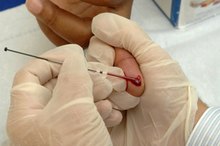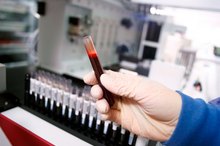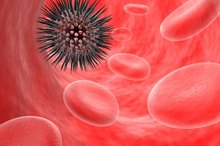How to Read CBCD Blood Test Results
A Complete Blood Count (CBC) is a blood test with many components to determine infections and bacteria in the body. There are nine different tests which make up a CBC. One of which is CBC with Differential (CBCD), a common lab test ordered for routine checkup or annual physicals. The differential count measures the five major types of white blood cells. Significant increase and decrease of the percentages of these cells can help the diagnosis of some medical conditions.
If you are experiencing serious medical symptoms, seek emergency treatment immediately.
Check to see if your neutrophil count is between the normal adult level of 48 to 73 percent. High levels can be a sign of active infection while low levels indicate threatened immune system. Neutrophils are the main guardians against infection.
Blood Cell Count & Infections
Learn More
Read your lymphocyte count to see if you are clear of viral infections like measles, rubella and chickenpox. The desired count is 33 and the normal range is 18 to 48 percent. Lymphocytes shield the body from viral ailments.
Determine your overall resistance with the monocyte count. A normal percentage is 4.5. Monocyte counts higher than 9 percent is usually present in major tissue malfunction as in the cases of carcinoma, lymphoma or leukemia.
Five Types of White Blood Cells
Learn More
See if your eosinophil count is higher than 5 percent. Increased levels indicate allergic reaction, while low levels are no cause for alarm. Eosinophils protect your body from parasites and most infections.
Evaluate the level of your basophil count, as a final check to identify your resistance to allergies. Your percentage should not be higher than 2 percent. Low levels are normal.
Tips
To obtain accurate CBCD blood test results, a 10-hour fast is required before testing.
Always discuss your CBCD blood test results with your physician, so that proper treatment can be administered for your condition.
Related Articles
References
- Vermeire S, Van assche G, Rutgeerts P. Laboratory markers in IBD: useful, magic, or unnecessary toys? Gut. 2006;55(3):426-31. doi:10.1136/gut.2005.069476
- Kabat GC, Kim MY, Manson JE, et al. White Blood Cell Count and Total and Cause-Specific Mortality in the Women's Health Initiative. Am J Epidemiol. 2017;186(1):63-72. doi:10.1093/aje/kww226
- Riley LK, Rupert J. Evaluation of Patients with Leukocytosis. Am Fam Physician. 2015;92(11):1004-11.
- Newburger PE, Dale DC. Evaluation and management of patients with isolated neutropenia. Semin Hematol. 2013;50(3):198-206. doi:10.1053/j.seminhematol.2013.06.010
- Vermeire S, Van Assche G, Rutgeerts P. Laboratory markers in IBD: useful, magic, or unnecessary toys? Gut. 2006;55:426-31.
- Wilkins T, Jarvis K, Patel J. Diagnosis and management of Crohn's disease." Am Fam Physician. 2011;84:1365-75.
Tips
- To obtain accurate CBCD blood test results, a 10-hour fast is required before testing. Always discuss your CBCD blood test results with your physician, so that proper treatment can be administered for your condition.
Writer Bio
LaTasha Favors has been writing professionally since 2008. She specializes in travel- and health-related topics and has published articles on various websites, including Search-costa-rica.com and MyFrenchRealEstate.com.








